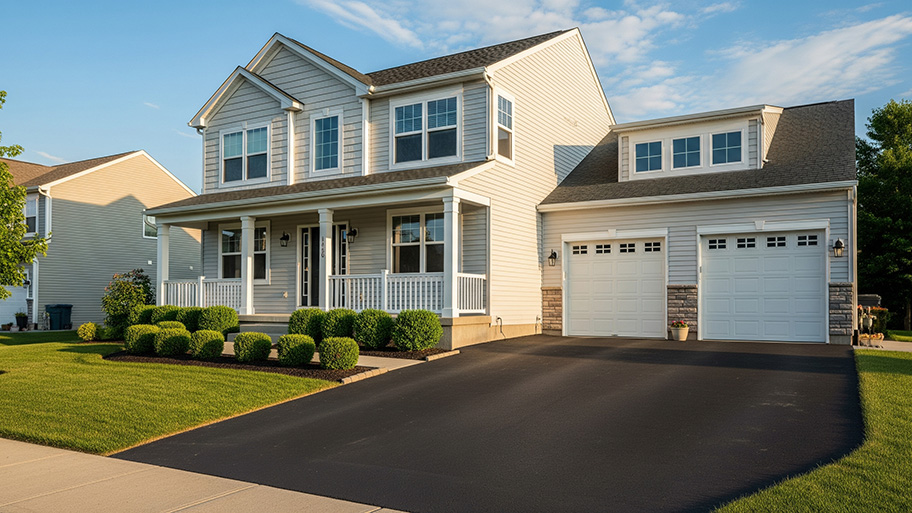
Use our guide to calculate the cost to seal an asphalt driveway. Prices vary based on the type of sealant and the size of the driveway.
Don’t let your vehicle get the cold feet
There are three major types of heated driveways: hydronic, electric, and portable heated mats.
Heated driveway installation costs $13,000 on average.
Heated driveways have many advantages in extreme winter conditions.
Heated driveways may increase your property value.
If you are tired of shoveling snow and de-icing your driveway every winter, a heated driveway may be worth considering. This guide will discuss the pros and cons of heated driveways, their alternatives, and installation and maintenance costs to help you determine whether a heated driveway is right for your home.
When taking on this project, expect questions only a pro can answer. With our network of local pros, you'll get the job done and your questions answered—without the hassle and stress of doing it yourself.
Heated driveways use one of the following radiant heating systems to keep the driveway surface at a certain temperature: hydronic heating, electric heating, or portable heated mats.
Hydrolic heated driveways rely on a boiler and pump to circulate antifreeze through PVC pipings in the concrete or asphalt. Electric heated driveways activate metal heating coils under the pavement through a wall-mount switch and can reach over 200º F. Finally, portable mats can be installed seasonally and can be a more affordable and flexible option if you only need to prevent freezing on the driveway for a short period in the winter.
| Pros of heated driveways | Cons of heated driveways |
|---|---|
| Prevents freeze and slip incidents | High installation cost |
| No more maintenance needs for snow shoveling and de-icing | The installation process tends to be intrusive |
| Protects driveway from salt and snow damage. | Temperature differences may damage the driveway surface |
| May increase property value. | Hard to repair |
Heated driveways come with many advantages. The major pros of heated driveways include:
Improved safety: Zero freezing means zero chances of slipping and falling. If you live with elders or those with disabilities, having a heated driveway can drastically reduce potential safety hazards caused by freezing weather conditions.
Reduced salt damage: A heated driveway will significantly reduce the salt damage endured by the driveway’s surface throughout the winter.
Low maintenance: Ultimately, the best part of having heated driveways is never having to worry about shoveling snow or de-icing the driveway. For some, the effortlessness is well worth the investment.
Increase property value: Heated driveways can usually boost your property’s value, especially if you live somewhere with severe winter climates.
The most significant and almost the only drawback of heated driveways is their extremely high cost. Not only is the heating system costly, but hydronic and electric heated driveways both require you to completely redo the driveway surface. Similarly, if something goes wrong, you may have to tear open the driveway to make any repairs. Therefore, you must also factor in the additional cost associated with resurfacing your driveway, which costs $4,910 on average, depending on your choice of material and scope of work.
Another concern with heated driveways is uneven temperature distribution. If you have a concrete driveway, the difference between the cold surface and the heating system can cause the concrete to crack. This often happens with hydronic heating tubes where the fluid temperature is significantly higher than the slab temperature.
Fortunately, heated driveways aren’t the only option for keeping your car free from freezing during cold weather. Portable heated mats are a great alternative to full-on heated driveways since they’re essentially just heating pads that can be installed and removed accordingly.
Contracting out basic snow removal services is another great alternative. Compared to the cost of installing a heated driveway, hiring a subcontractor or your neighbor’s teenage son to shovel your driveway might be the way to go.
A heated driveway costs $13,000 on average to install, although you may be able to keep it between $3,000 to $8,700, depending on the heating method, size of the driveway, and your local contractor’s work rate. Since it is a hefty investment, it’s important to weigh the pros and cons before making a decision.
Heated driveways are major upgrades that must be completed by a licensed and insured driveway contractor. If you live somewhere with frequent snow and freezing weather in the winter, a heated driveway can ensure your safety and increase your property’s value. Otherwise, shoveling and salting your driveway the traditional way tends to be far more cost-effective.
You may also consider adding a heated driveway if you consider your current residence to be your “forever home” since the pricing makes it more reasonable to treat heated driveways as a long-term investment.
From average costs to expert advice, get all the answers you need to get your job done.

Use our guide to calculate the cost to seal an asphalt driveway. Prices vary based on the type of sealant and the size of the driveway.

The cost of a tar and chip driveway falls between gravel and asphalt. Is this unique process the happy medium you've been looking for? Let's take a look.

The cost to build a road on your property can be high, but the utility is often worth it. Use this cost guide to see how much this project will cost.

Everything you need to know about the pros and cons of having a decomposed granite driveway at your home based on price, life span, and performance.

Recycled asphalt is a less expensive, eco-friendly alternative to standard asphalt. Learn all about recycled asphalt driveways to see if it’s right for you.

If your driveway has seen better days, it might be time for repairs or a replacement. Use this guide to figure out the best way to restore your driveway’s appearance.